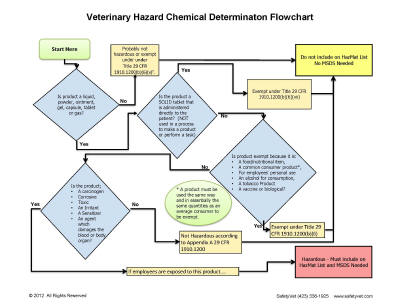How do we know which chemicals are hazardous?
Perhaps the most frustrating part of this regulation is determining exactly which chemicals are hazardous. The assumption must be that a chemical is hazardous unless it is one of the exempt items (see below) or until it is proven otherwise by objective data. Start by reading the label; if there are warnings such as, "Caution, Danger, Warning, Toxic, Flammable, Reactive or Corrosive", then it is most likely considered a hazardous material. If the label does not contain such a warning (many drugs do not contain these warnings) check the package insert or accompanying literature for warnings. The determination of a chemical’s hazard status is based on the presence of health or physical hazard to workers. Many materials that have used for years without apparent trouble and never thought of as hazardous could become a real danger in certain situations. It's also known that every person reacts to chemicals differently; substances that apparently have little effect on one person can be severely irritating to another, so it’s better to err on the side of caution when making the determination of a chemical’s hazard potential.
Health hazard - means a chemical for which there is statistically significant evidence based on at least one study...that acute or chronic health effects may occur in exposed employees.
A chemical is considered a health hazard if it falls into one of the following categories:
- Carcinogen
- Toxic (reproductive, hepato-, neuro-, nephro-, hemato-)
- Irritant
- Sensitizer
- Any agent which damages the lungs, skin, eyes, or mucous membranes.
Physical Hazard -means a chemical for which there is scientifically valid evidence that it is:
- a combustible liquid,
- a compressed gas,
- explosive,
- flammable,
- an organic peroxide,
- an oxidizer,
- pyrophoric,
- unstable (reactive), or
- water-reactive.
It’s easy to see that almost any chemical can fit into this list somewhere. Although the manufacturer of the chemical relays this information to the user on the label and the SDS, employers do have the ability to alter the severity of the hazard to suit the situation. For instance, in a concentrated form, a particular chemical may be an acute health hazard, but once the chemical is diluted to the concentration that is used in the hospital, the health hazards are very minimal. The employer has a great deal of latitude in this area, but there must be a sound, scientific basis for these decisions.
Click here to view a PDF file of the Veterinary Hazard Chemical Determination Flowchart
When two or more chemicals are mixed together, the result could be a simple compound of the two or it may be a different chemical altogether. When a practice mixes chemicals (e.g., for a special ear or hoof treatment) and their employees are exposed to them, the practice may be held to the requirements of a chemical manufacturer. These requirements include the scientific testing of the chemical as well as the preparation of a MSDS detailing its properties. OSHA rarely gets involved in the situation when medications are mixed and dispensed directly to the client. However, if the solution/mixture is made up in advance and could affect employees, OSHA would look closely at the hazard!
Exemptions
As with every rule, there are exceptions. Although OSHA's mandate is to protect workers from occupational injuries and illnesses, they recognize that some products which could fall into the category of "hazardous" are so commonly used, employees are in no more danger in the workplace than in their homes. These categories of products are exempt from the entire provisions of the HCS:
Hazardous waste - This material is regulated by the Environmental Protection Agency, and not OSHA.
Tobacco or tobacco products - Regulated by the FDA not OSHA.
Articles - These are products made up of hazardous materials, but when the manufacturing process is complete, the finished item poses no hazard during foreseeable use, e.g., autoclave tape, self-contained laboratory cassettes where no liquids other than the sample are added by the user, thermometers, laboratory "dip sticks", consumer batteries and printer toner or ink cartridges.
Food or nutritional products (including vitamins, IV fluids and milk replacement formulas.
Foods, drugs, or cosmetics intended for personal consumption by employees while in the workplace.
Any common consumer product that is used in substantially the same manner (frequency, duration & quantities) as normal consumer use. This means things like window cleaner, laundry detergent, liquid correction fluid, etc. can be exempted unless your hospital uses these products differently than the average consumer. Be careful though; some normal consumer products like peroxide, alcohol or even bleach would not be exempted because the typical veterinary hospital would use these products at a greater frequency than the normal consumer
Any drug (medication) when it is in solid final form for direct administration to the patient (e.g., tablets or pills). This exemption does not prohibit the pills from being crushed or dissolved prior to administration but the exemption does not apply if the pills are used as an ingredient to make another product (e.g., compounding or manufacturing.) There is some disagreement among OSHA Compliance Officers whether this exemption applies to capsules; we recommend hospitals INCLUDE capsules in their HAZMAT program. The drug exemption does NOT exempt medications in liquid, gel or powder forms.
These are total exemptions from the standard which means that the chemicals can be unconditionally excluded from the program. There are other exemptions for retail establishments where employees NEVER open the package of chemicals and for shipping operations where employee exposure is unlikely. These exemptions are generally not useful in the veterinary profession.
Did You Know...?
According to OSHA Pamphlet 3695,
"No one knows exactly how many chemicals may be present in American workplaces. The total number of chemical substances that have been developed and registered in the Chemical Abstracts Service Registry reached 60 million in 2011—the last 10 million of those were added in less than two years."
https://www.osha.gov/Publications/OSHA3695.pdf

